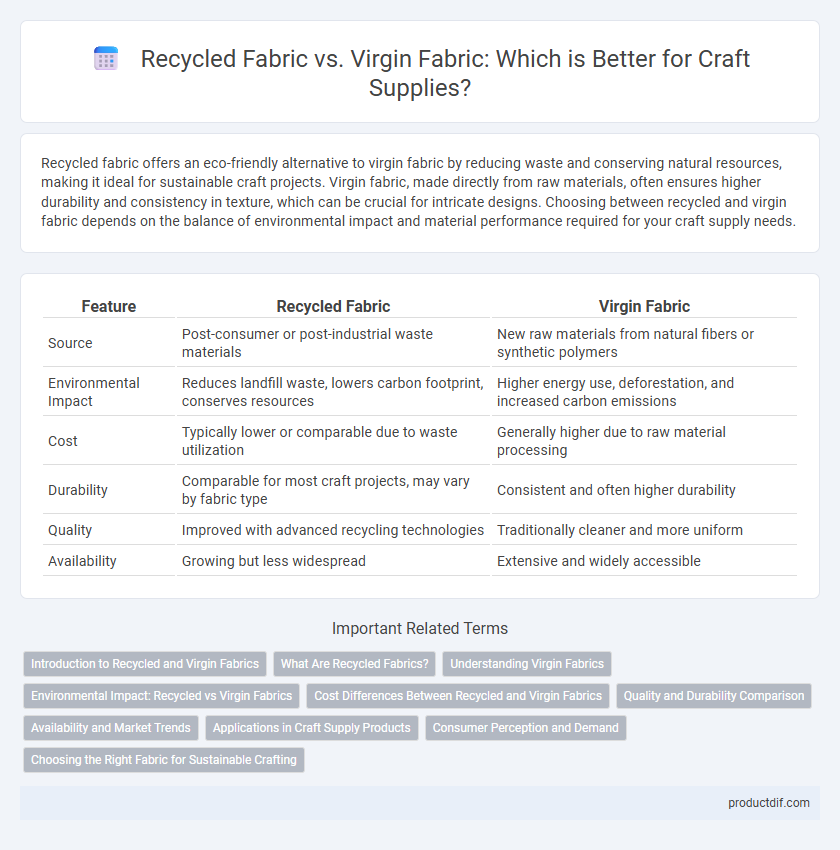Recycled fabric offers an eco-friendly alternative to virgin fabric by reducing waste and conserving natural resources, making it ideal for sustainable craft projects. Virgin fabric, made directly from raw materials, often ensures higher durability and consistency in texture, which can be crucial for intricate designs. Choosing between recycled and virgin fabric depends on the balance of environmental impact and material performance required for your craft supply needs.
Table of Comparison
| Feature | Recycled Fabric | Virgin Fabric |
|---|---|---|
| Source | Post-consumer or post-industrial waste materials | New raw materials from natural fibers or synthetic polymers |
| Environmental Impact | Reduces landfill waste, lowers carbon footprint, conserves resources | Higher energy use, deforestation, and increased carbon emissions |
| Cost | Typically lower or comparable due to waste utilization | Generally higher due to raw material processing |
| Durability | Comparable for most craft projects, may vary by fabric type | Consistent and often higher durability |
| Quality | Improved with advanced recycling technologies | Traditionally cleaner and more uniform |
| Availability | Growing but less widespread | Extensive and widely accessible |
Introduction to Recycled and Virgin Fabrics
Recycled fabric is created from repurposed textile waste, reducing environmental impact by minimizing landfill use and conserving resources. Virgin fabric, made from newly harvested fibers such as cotton, polyester, or wool, offers consistent quality and durability. Both fabric types serve distinct roles in eco-friendly crafting and traditional textile production, influencing sustainability and product performance.
What Are Recycled Fabrics?
Recycled fabrics are textiles produced from repurposed materials such as post-consumer garments, industrial fabric scraps, or plastic waste, reducing environmental impact compared to virgin fabrics. These fabrics help decrease landfill waste, lower carbon emissions, and conserve resources by minimizing the need for new raw materials. Common recycled fabrics include recycled polyester from plastic bottles and regenerated cotton, offering sustainable options for eco-friendly craft supplies.
Understanding Virgin Fabrics
Virgin fabrics are produced directly from natural fibers or synthetic polymers that have not been previously used or processed, ensuring maximum purity and durability. These materials offer consistent texture, strength, and color retention, which are essential for high-quality craft projects requiring precision and longevity. While virgin fabrics provide superior performance, they typically have a higher environmental impact compared to recycled alternatives due to resource-intensive production processes.
Environmental Impact: Recycled vs Virgin Fabrics
Recycled fabrics significantly reduce landfill waste and lower carbon emissions compared to virgin fabrics, which require more water, energy, and raw materials for production. Virgin fabrics, derived from new fibers like cotton or polyester, contribute to higher environmental degradation due to intensive resource extraction and chemical use. Choosing recycled fabric minimizes ecological footprint by promoting circular textile economies and conserving natural resources.
Cost Differences Between Recycled and Virgin Fabrics
Recycled fabrics generally cost less than virgin fabrics due to lower raw material expenses and reduced environmental impact fees. Virgin fabrics often involve more intensive resource extraction and energy consumption, driving up their market price. Price variations depend on fabric type, production scale, and supply chain efficiency, with recycled options becoming increasingly competitive.
Quality and Durability Comparison
Recycled fabric often exhibits slightly lower tensile strength compared to virgin fabric due to fiber degradation during recycling, affecting overall durability in high-stress craft projects. Virgin fabric maintains consistent fiber integrity and resilience, offering superior longevity and quality, especially for items requiring frequent use or washing. Choosing between recycled and virgin fabric involves balancing sustainability benefits with the specific durability demands of the craft application.
Availability and Market Trends
Recycled fabric availability is increasing rapidly, driven by growing consumer demand for sustainable craft supplies in the market. Virgin fabric remains more widely accessible due to established manufacturing processes and lower production costs, maintaining dominance in mainstream craft stores. Market trends indicate a rising preference for eco-friendly recycled fabrics, with brands expanding their offerings to include diverse textures and colors for crafting enthusiasts seeking sustainable options.
Applications in Craft Supply Products
Recycled fabric offers an eco-friendly alternative for crafting supplies, widely used in products like tote bags, quilts, and home decor, emphasizing sustainability in creative projects. Virgin fabric provides consistent quality and vibrant colors, making it ideal for detailed embroidery, apparel crafts, and precision-based textile art. Both fabrics support diverse craft supply applications, with recycled options appealing to eco-conscious crafters and virgin materials favored for durability and aesthetic versatility.
Consumer Perception and Demand
Recycled fabric appeals to eco-conscious consumers seeking sustainable craft supplies, often perceived as environmentally responsible yet sometimes associated with lower durability compared to virgin fabric. Virgin fabric maintains strong demand due to its consistent quality and vibrant appearance, attracting crafters prioritizing material performance and aesthetic appeal. Market trends reveal growing consumer interest in recycled fabric, driven by increasing awareness of environmental impact and the value placed on circular economy principles.
Choosing the Right Fabric for Sustainable Crafting
Recycled fabric reduces environmental impact by repurposing waste materials, conserving water, and lowering carbon emissions compared to virgin fabric, which relies on resource-intensive production from raw fibers. Selecting recycled fabrics like recycled polyester or cotton blends supports circular economy practices and minimizes landfill contribution. Crafting with recycled materials promotes sustainability without compromising durability or aesthetic quality, making it the preferred choice for eco-conscious projects.
Recycled fabric vs Virgin fabric Infographic

 productdif.com
productdif.com